Anon Collective (ed.): Book of Anonymity (2021)
Filed under book | Tags: · anonymity, anonymous, art and science, data, digital culture, personhood, privacy, security, surveillance, technology

“Anonymity is highly contested, marking the limits of civil liberties and legality. Digital technologies of communication, identification, and surveillance put anonymity to the test. They challenge how anonymity can be achieved, and dismantled. Everyday digital practices and claims for transparency shape the ways in which anonymity is desired, done, and undone.
The Book of Anonymity includes contributions by artists, anthropologists, sociologists, media scholars, and art historians. It features ethnographic research, conceptual work, and artistic practices conducted in France, Germany, India, Iran, Switzerland, the UK, and the US. From police to hacking cultures, from Bitcoin to sperm donation, from Yik-Yak to Amazon and IKEA, from DNA to Big Data — thirty essays address how the reconfiguration of anonymity transforms our concepts of privacy, property, self, kin, addiction, currency, and labor.” (from back cover)
Contributors: Anon, Götz Bachmann, Dwaipayan Banerjee, Solon Barocas, Aram Bartholl, Amelie Baumann, Vadim Bernard, Paula Bialski, Andreas Broeckmann, Heath Bunting, Martin De Bie, Bureau d’études, Jacob Copeman, Abigail Curlew, Stéphane Degoutin, Simon Farid, Parastou Forouhar, Randi Heinrichs, Anna Henke, Michi Knecht, knowbotiq, Gertraud Koch, Julien McHardy, Helen Nissenbaum, Gerald Raunig, RYBN.ORG, Daniela Silvestrin, Thorsten Thiel, Transformella, Daniël de Zeeuw, Nils Zurawski.
Publisher Punctum Books, March 2021
Creative Commons BY-NC-SA 4.0 International license
ISBN 9781953035301
484 pages
HT coco
PDF (11 MB)
Comment (0)Winnie Soon, Geoff Cox: Aesthetic Programming: A Handbook of Software Studies (2020)
Filed under handbook | Tags: · aesthetics, algorithm, code, computation, data, programming, software, software studies

“Aesthetic Programming explores the technical as well as cultural imaginaries of programming from its insides. It follows the principle that the growing importance of software requires a new kind of cultural thinking — and curriculum — that can account for, and with which to better understand the politics and aesthetics of algorithmic procedures, data processing and abstraction. It takes a particular interest in power relations that are relatively under-acknowledged in technical subjects, concerning class and capitalism, gender and sexuality, as well as race and the legacies of colonialism. This is not only related to the politics of representation but also nonrepresentation: how power differentials are implicit in code in terms of binary logic, hierarchies, naming of the attributes, and how particular worldviews are reinforced and perpetuated through computation.
Using p5.js, it introduces and demonstrates the reflexive practice of aesthetic programming, engaging with learning to program as a way to understand and question existing technological objects and paradigms, and to explore the potential for reprogramming wider eco-socio-technical systems. The book itself follows this approach, and is offered as a computational object open to modification and reversioning.”
Publisher Open Humanities Press, 2020
Creative Commons BY-SA License
ISBN 9781785420948
293 pages
Review: David Young (Computational Culture, 2021).
PDF, PDF
HTML (added on 2021-6-8)
Git
Eintritt in ein Lebewesen. Von der sozialen Skulptur zum Plattform-Kapitalismus / Journey Into a Living Being: From Social Sculpture to Platform Capitalism (2020) [German/English]
Filed under catalogue | Tags: · art, capitalism, data, internet, platform, privacy, social media, surveillance

“In 1977, Joseph Beuys presented his installation Honey Machine at the Workplace at documenta 6, in which tubes ran into the exhibition rooms, through which honey was pumped. The work symbolized Beuys’ idea of the expanded concept of art and of social sculpture. “Everyone is an artist” is his famous motto –not because everyone can paint, dance or make music, but because we all contribute through our productivity to a collective creativity that can be weighed as real capital and societal potential, to which Beuys ascribed the formula “art = capital.” Honey as the “spiritual nutrition of the cosmos” (Beuys) is the embodiment of this collective creativity.
These days, we deliver our creative “honey” voluntarily to internet companies like Google, Facebook, Twitter, TikTok or Amazon. Computers and smartphones, online speakers and fitness wristbands upload a large portion of our data to these companies’ servers. Even rental bikes and e-scooters collect our location data. Our every click, every Like, every photo posted and every online comment is fuel for the companies of “surveillance capitalism” (Shoshana Zuboff). They use our data to sell advertising, predict our behavior, optimize their algorithms and AI, and to keep competing companies out of the market as much as possible.
The exhibition Journey Into a Living Being takes its name from a lecture Beuys gave on social sculpture at documenta. It traces the conceptual trajectory to the present, in which the internet and social media are replete with offers of creative services, but where only few reap the financial rewards. It brings together artworks spanning forty years with the aim of deciphering what has come to pass between the development of social sculpture and the rise of platform capitalism and the gig economy, and how this process is reflected in art.”
Edited by Tilman Baumgärtel
Publisher Kunstraum Kreuzberg/Bethanien, Berlin, 2020
ISBN 9783000652608, 3000652604
111 pages
Exhibition (18.5-16.8.2020)
WorldCat
PDF (6 MB)
Comment (0)
